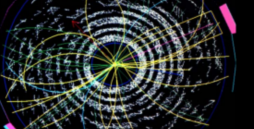Speaker
Mr
Christopher Hilgenberg
(Colorado State University)
Description
The ICARUS T600 liquid argon time-projection chamber will be the far detector for the Short Baseline Neutrino Program. The detector will operate at shallow depth and therefore be exposed to the full surface flux of cosmic rays. Application of overburden attenuates most of this background expected for muons. However, the remaining background is problematic since a photon produced by a muon passing in close proximity to the T600 active volume can be mistaken for a neutrino event. In principle, a large fraction of these events can be removed from the data through application of selection cuts as suggested by Monte Carlo studies. However, this method of background rejection reduces fiducial target mass and renders analysis of the systematics
difficult.
A straightforward way to remove the cosmic muon background more thoroughly is to utilize a detector external to the liquid argon active volume capable of tagging thoroughgoing cosmic muons with high efficiency (e.g. > 95%). Ideally, this external cosmic ray tagger (CRT) would provide full geometric coverage of the T600. During the past 18 months at Colorado State University (CSU), we performed
Monte Carlo studies of the tagging efficiencies of the system and conducted an extensive research and development program of such a system based on extruded organic scintillator, wavelength-shifting fibers, and silicon photomultipliers. Subsequently, it was decided that our European colleagues would design and construct the top portion of the CRT while the US groups would provide the side (~400 m^2) and bottom (~215 m^2) portions using salvaged MINOS veto shield modules on the sides and Double Chooz veto modules on the bottom. These two systems will need to be tested for basic functionality and to have their detailed response characterized in order to optimize the system configuration as well as prepare for future analysis tasks and integration with the other detector sub-systems.
Primary author
Mr
Christopher Hilgenberg
(Colorado State University)
Co-authors
Anne Schukraft
(Fermilab)
Mr
David Warner
(Colorado State University)
Prof.
Robert Wilson
(Colorado State University)
